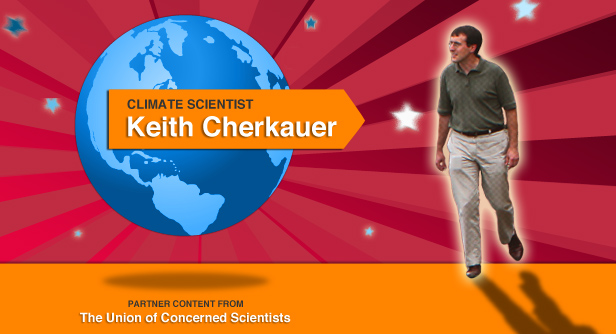Camille Parmesan studies the effects of global warming by chasing butterflies. Sounds fanciful, but it is anything but. Her careful field observations of butterfly populations have produced compelling evidence of how climate change has already affected our living planet. In several landmark studies, she has helped pave the way for a body of eye-opening research that has tracked changes in numerous populations of plants and animals.
It all started back in the early 1990s, when Parmesan was a graduate student happily studying the diet of the Edith’s checkerspot butterfly (Euphydryas editha). She was drawn into the field by her love of nature and of the butterflies themselves. “You get a feel for the pulse of the species you are working with,” Parmesan says, “a kind of intuition about them.” Observing checkerspots in the field, Parmesan detected changes in their vulnerable populations and realized that the butterflies could be sensitive indicators of global warming.

Unlike the better-known monarch butterflies, which are migratory, Edith’s checkerspots inhabit distinct patches no larger than the area of several football fields. “These butterflies travel only hundreds of yards in their entire lifetime,” Parmesan explains. “Because these small populations are so sedentary, they will simply go extinct if their habitat is degraded by climate change.”
Parmesan spent four and a half years tracing the checkerspot from Baja to Banf, the species’ entire range in the western part of the North American continent. She visited and revisited the checkerspot’s known habitats, which were scattered across thousands of miles of terrain. At each locale, Parmesan would crawl on hands and knees to look for evidence of the butterflies and the telltale damage they do to host plants. “Six months of the year,” Parmesan recalls, “I lived out of my car in a tent.”
The work paid off. Parmesan’s landmark 1996 paper in the British science journal Nature was one of the first definitive looks at the effects of climate change on a living species. When she started out tracking checkerspots, Parmesan wasn’t sure she’d be able to discern any effects of climate change. But even discounting sites where urban sprawl or other human interference might have impinged upon the butterflies’ habitat, Parmesan was startled to find that at the southern edge of their range, in Mexico and southern California, populations of Edith’s checkerspots had declined by 80 percent.
Her carefully executed study clearly documented that global warming was already affecting at least one species. Parmesan’s results spurred a veritable flood of research to assess the effects of climate change on the planet’s other plants and animals. Her pioneering work placed Parmesan at the very center of a burgeoning new field of research.
In the ensuing years, Parmesan, now a biologist at the University of Texas at Austin, broadened her focus. “I saw an opportunity to look more widely at the issue because policymakers needed to know what was happening with the natural world,” she says. “But there were incredibly few biologists working on this subject to help inform them.”
For instance, taking advantage of better record keeping by butterfly collectors and aficionados in Europe, Parmesan was able to join with colleagues to determine that, like the checkerspot, nearly two-thirds of some 57 species of nonmigratory European butterflies were similarly dying out on the southern edge of their ranges, which were shifting northward and to higher elevations.
Broadening her scope even further, Parmesan teamed with economist Gary Yohe at Wesleyan University to analyze the new biological studies she had helped inspire. Combing the literature and subjecting data on nearly 1,700 species to a stringent set of criteria, Parmesan and Yohe found strong scientific evidence that some 52 percent of all wild species studied show signs of having been affected by climate change. For example, habitats have shrunk or shifted north or to higher elevations, animal species are breeding earlier in the year, and many varieties of plants are blooming earlier than ever before.
“A huge number of species are affected,” says Parmesan, adding that the evidence is “more pervasive and widespread than almost any biologists expected.” Parmesan and Yohe’s 2003 paper in Nature is still one of the most widely cited articles in the field of ecology, and is regarded as presenting some of the strongest statistical evidence yet that global warming is having an impact on a wide swath of species and regions. In the years since that article appeared, the research results have become even stronger, says Parmesan, bespeaking “an urgent need for scientists to communicate more directly to the public about the latest studies so there isn’t so much of a lag in public understanding about the effects of climate change.”
Parmesan’s newest research effort will take her to the Alps and to the Scandinavian tundra where she will try and tease apart why some butterfly species seem more sensitive to global warming than others. The research, she hopes, will help biologists “predict which species might be most sensitive over the next 100 years.”
In the meantime, Parmesan’s research-including her work as a lead scientist on the United Nation’s Intergovernmental Panel on Climate Change (IPCC)-has led her to urge conservation biologists and nonprofit groups to shift their focus from protecting particular pieces of land toward protecting and creating what she calls “habitat corridors,” and gearing up to undertake “assisted colonization” efforts; that is, repopulating some plant and animal species in more suitable climes to protect them from extinction. Only efforts of this sort, she says, can facilitate the “continent-level kind of movements of species we’re going to need.”
“The latest research shows clearly that we face the threat of mass extinctions in coming years,” Parmesan says. “My hope is that we will be able to reduce [greenhouse gas] emissions enough so that assisted colonization efforts can be successful, because at the higher ranges of scientists’ projections of warming trends, frankly, we’re sunk.”
This is the fifth installment of America’s Climate Scientists: A series from the Union of Concerned Scientists. Click here to read all the climate scientist profiles.
The Union of Concerned Scientists is currently leading a campaign to elevate the voices of climate scientists and educate the public about the overwhelming scientific evidence for human-caused global warming. Learn how you can get involved at www.ucsusa.org/evidence.



